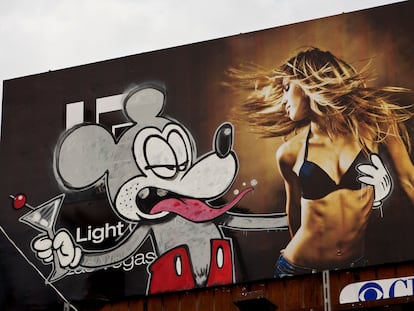90 years of Donald Duck: Why Disney’s grumpiest character has been such a success
EL PAÍS enters Walt Disney Studios to dive into the archives where millions of scripts, posters and objects from its films and characters are kept, looking specifically for the famous cartoon figure, which made its first appearance nine decades ago
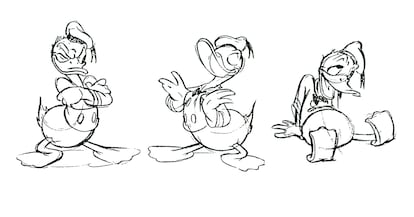

When Walt Disney first thought of Donald Duck, the world’s most famous animation studio was just a small workshop for creating drawings. It was 1931 and Donald’s name was mentioned in an illustrated book called The Adventures of Mickey Mouse; there was also a duck on the back cover. It was three years before Donald, having become a character, appeared in a short film called The Wise Little Hen. He was going to be a secondary character, but it soon became clear that his comic vision made him the star. From then on, he appeared in more shorts, books, cartoons... and the rest is history.
Although Mickey Mouse is the undisputed king of the so-called House of Mouse, Donald Duck is the prince of Disney, which has become an international conglomerate worth $200 billion, with dozens of publicly traded brands. With Donald Duck now 90 years old, Disney decided to celebrate the character by opening its Burbank studios to EL PAÍS and explaining the secrets of his long-lived triumph.
How has a duck dressed in a blue jacket, a red bow tie and no pants become a symbol of Disney, a studio of heroes, princesses and villains? Longtime staff at Disney, who have seen the character evolve, have no doubt that it comes down to his personality. While Mickey, Minnie, Daisy, Pluto, Goofy are affable, good-humored, affectionate, Donald is grumpy. He gets angry, screams, kicks, literally climbs the walls. In other words: he is human. And that, in a world of animated perfection, makes him stand out. The people who have been watching these characters for years — sometimes decades — understand the secrets of their success.
The once small offices of Walt and Roy Disney have grown a lot in the past 101 years: in staff (they have more than 200,000 employees), size and popularity. In 1937, when Snow White and the Seven Dwarfs became an unrivaled box office success (grossing more than $8 million, today, with inflation, the equivalent of more than $173 million), the brothers bought a huge piece of land in the north of a then expanding city, close to where the Warner brothers and the then successful Universal Pictures also purchased land. That area has now become the Walt Disney Studios (not open to the public), which are made up of a dozen buildings such as the animation, drawing and administrative offices, Walt’s old office — which is as he left it when he died in 1966 —, a canteen, a cinema and, of course, huge archives.
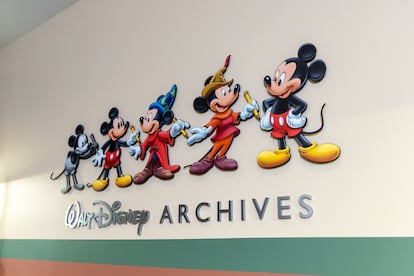
Becky Cline, 64, is responsible for the archives. He has been overseeing them for almost 15 years — directing 42 people — and 35 years in the company. She is also, as she herself says, an expert in Disney history, and knows the characters in depth, especially the classic ones. “From the beginning, the public loved him,” she says of Donald Duck. “He’s adorable, but also irascible, mischievous, crazy. He gets himself into trouble on his own; I think a lot of times we’d like to be able to lose our heads like he does,” says Cline.
Donald Duck has changed very little since his creation. At first, he had a longer beak and slightly different colors, but that’s it. This also helps explain why his image has been so enduring. Another factor was the work that Donald Duck carried out.
“In the 1930s and 1940s, he was very popular in cartoons and comics... especially until Scrooge McDuck arrived [in 1952],” Becky recalls. “In the 1940s, he was a very important figure in the United States because he was engaged in positive propaganda during the war. He went on to earn as many as 400 military insignia,” Cline explains, showing a figure of Admiral Donald Duck. “Much more than just a sailor,” she laughs.
“He represented the government and Defense, and in 1943 he starred in a campaign to encourage people to pay taxes, a war effort. In the 1950s, he was engaged in public service, teaching safety to children,” adds the Disney history expert.

The Disney archives store “millions and millions of documents,” explains Cline, who prefers not to give specific figures, but says that, for example, there are about “25 million photos.” The archives were founded in June 1970, although the building where they are located dates back to 1997. “In 1934, there were already Donald Duck products. It is a type of product that is difficult to find, rare and highly collectible,” she explains. At that time, what’s more, copies were not kept of everything. “Only extremely valuable things: scripts, storyboards....,” explains Cline. Disney also preserves memorabilia and, rather than making purchases — which only happens on rare occasions — they accept donations.
Donald had some special features as the “youngest son” of the company, such as more freedom when it came to licensing. For example, in 1947 he became the mascot of the University of Oregon. The educational center’s animal was a duck, but “thanks to Walt Disney’s benevolence,” as the university itself explains, they reached an agreement, and he became the mascot, “as long as he was portrayed in good taste.” Donald also appeared in lots of curious objects that Cline keeps in the archives: from stickers and soda bottles to juice and ketchup cans. He came to be featured on ice cream, frozen fish fillets and all kinds of market produce. “I love the fan cards,” Cline admits. These cards are a kind of postcard, with a drawing of the duck, that Walt Disney himself signed and sent to fans who wrote to him about how much they liked Donald.
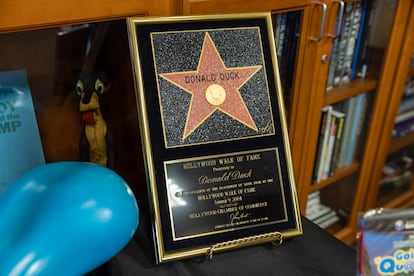
The vice president of character art, Stéphane Kardos — who has been with Disney for 27 years — explains that Donald is an “extremely popular character in Europe, and is so because of his personality: he is fun, iconic, truly authentic.” To mark his 90th birthday, Disney decided to bring back Donald Duck to the fore. It has partnered with dozens of brands (Kardos does not specify exactly how many) to make everything from sweatshirts and Funko dolls to jewelry, suitcases, watches, sunglasses, clothes... “His followers will be able to connect with him and there will also be special objects for collectors,” explains Kardos.
The nonagenarian Donald has starred in 11 Oscar-nominated films. And beyond his image and his bad temper, what many remember is his voice. “It’s very difficult to imitate,” admits Cline. Today, in the United States, it is Tony Anselmo who voices Donald Duck. He apprenticed with Clarence Nash, Donald’s original voice, who taught him in the 1980s. Nash — considered “a Disney legend” by the animation house — died in 1985 and since then, he has been the only official voice of the duck.
Anselmo isn’t currently training anyone to play Donald Duck. Nor is he willing to tell his secrets: “If I told you, I’d have to kill you,” he laughs. “It’s a business secret. It’s all in the mouth.” He does admit that when speaking as Donald, it “is not a voice as such”: “I don’t use my vocal cords, I can even do it with pharyngitis,” says Anselmo, who loves the work he has been doing for 40 years. “It’s something I’m very protective of, because it comes from Walt, and I respect him. I want to keep that tradition, that legacy, not change it. It’s not broken, so we don’t have to change anything, right?”
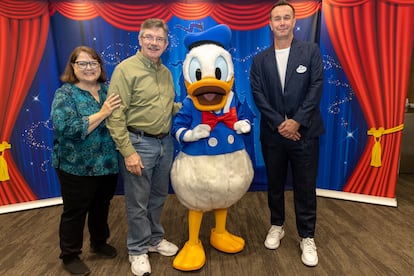
Sign up for our weekly newsletter to get more English-language news coverage from EL PAÍS USA Edition
Tu suscripción se está usando en otro dispositivo
¿Quieres añadir otro usuario a tu suscripción?
Si continúas leyendo en este dispositivo, no se podrá leer en el otro.
FlechaTu suscripción se está usando en otro dispositivo y solo puedes acceder a EL PAÍS desde un dispositivo a la vez.
Si quieres compartir tu cuenta, cambia tu suscripción a la modalidad Premium, así podrás añadir otro usuario. Cada uno accederá con su propia cuenta de email, lo que os permitirá personalizar vuestra experiencia en EL PAÍS.
¿Tienes una suscripción de empresa? Accede aquí para contratar más cuentas.
En el caso de no saber quién está usando tu cuenta, te recomendamos cambiar tu contraseña aquí.
Si decides continuar compartiendo tu cuenta, este mensaje se mostrará en tu dispositivo y en el de la otra persona que está usando tu cuenta de forma indefinida, afectando a tu experiencia de lectura. Puedes consultar aquí los términos y condiciones de la suscripción digital.
More information
Archived In
Últimas noticias
There is as much life left to discover on planet Earth as that which is already known
Dozens presumed dead, around 100 injured in fire at Swiss Alps bar during New Year’s celebration
Is porn for women different from conventional porn? We spoke to those who make it
Cartagena de Indias is sinking: What can the city do to mitigate it?
Most viewed
- David King, chemist: ‘There are scientists studying how to cool the planet; nobody should stop these experiments from happening’
- Reinhard Genzel, Nobel laureate in physics: ‘One-minute videos will never give you the truth’
- Oona Chaplin: ‘I told James Cameron that I was living in a treehouse and starting a permaculture project with a friend’
- Sinaloa Cartel war is taking its toll on Los Chapitos
- The Interoceanic Train, the Mexican alternative to the Panama Canal
